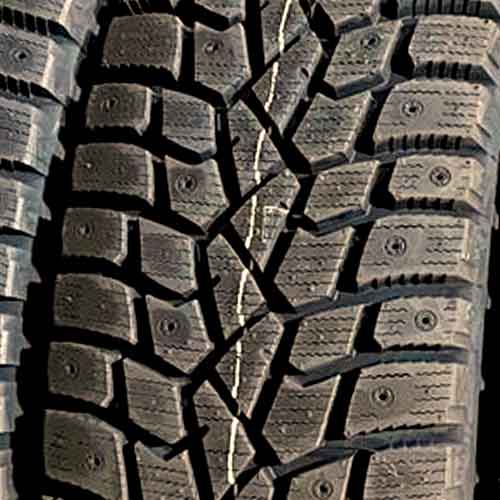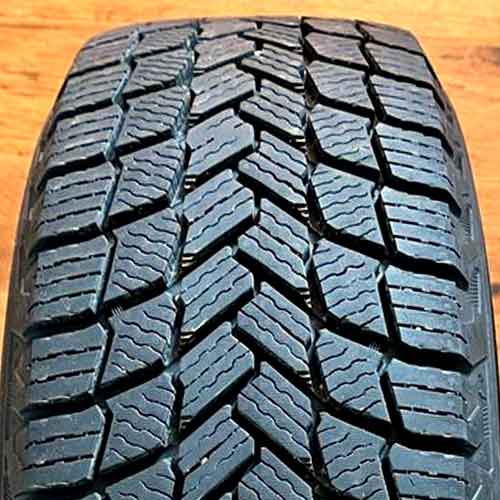Both the Michelin X Ice Snow and the Sumitomo Ice Edge showcase exceptional winter performance, each emphasizing different features and setting distinct standards in grip, durability, and comfort, catering to a diverse array of driving requirements and circumstances.

Table of Contents
Available Sizes
The Michelin X-Ice Snow comes in 125 total sizes in 15 to 22 inches. They have following specs.
- Speed ratings: T and H.
- Load ratings: SL and XL.
- Tread depth: 10.5/32″ on all.
- Weight: 16 to 40 lbs.
- Tread warranty: 40k miles.
Review X-Ice Snow in greater details: https://snowytires.com/michelin-x-ice-snow-review/
On the other side, the Sumitomo Ice Edge comes in 14 to 20 inches with following.
- Speed ratings: T only.
- Load ratings: SL and XL.
- Tread depth: 12/32″ on all.
- Weight: 16 to 33 lbs.
Tread Pattern
Starting with the Ice Edge, the tire is a meticulously engineered directional tire, a product of the esteemed Japanese manufacturer, Sumitomo.

The tread of this tire is distinguished by its five-rib pattern. Notably, compared to other winter tires, the lugs here are marginally more distanced, a feature that significantly enhances its self-cleaning capability.
The central (most) rib is populated by semi-triangular shaped lugs, enhanced with interlocking sipes and notches. These lugs are interconnected via robust longitudinal foundations, thereby delivering outstanding braking and acceleration performance.
The neighboring ribs are embedded with blocks that lean towards a squared-off form. Nonetheless, they also maintain substantial biting edges, complemented by stud holes.
The most aggressive elements of the tire, however, are the shoulder lugs. Their edges, adjoining the lateral tread voids, bear an intense serrated design. Consistent with the rest of the tire’s design, these blocks also incorporate wave-like siping and stud holes.
On the other side, the Michelin X-Ice Snow also features a unique, directional tread pattern.

This pattern is characterized by its 6 ribs, forming 5 longitudinal grooves.
Here the middle most groove is the narrowest, and is surrounded by blocks with snow vices, off-set edges and a mixture of interlocking and rectilinear siping.
While the surrounding lugs only carry wave-like siping, though they also have sharp edges to them.
All of these blocks also have reinforced foundations underneath, allowing for on-road stability.
Moving towards shoulder lugs, these are the most aggressive.
They carry thickest of all, siping, and their lateral sides are staggered.
Ice Performance
When it comes to performance on icy surfaces, the Michelin X-Ice Snow excels with its unique and intricate tread design featuring an amalgamation of different-sized angled slits and snow vices, setting a high standard in the industry.
The tire’s performance is further amplified by its aggressive siped pattern, which enhances braking distances and vehicle handling by providing additional biting edges, thus improving its grip on icy terrain.
However, the Sumitomo Ice Edge faces challenges under icy conditions due to its larger tread voids and fewer notches.
Its primary tread area struggles to maintain a firm grip on compacted ice, while the lack of multi-directional sipes diminishes its overall ice performance.
The Sumitomo Ice Edge does attempt to compensate by offering studdable lugs for enhanced traction on highly icy surfaces, but without studs, the Michelin X-Ice Snow continues to outperform on icy terrains.
Tread Life
The longevity of a tire’s tread life is largely influenced by the weight of the tire and its tread design.
And among the competitors, the Michelin X-Ice Snow is known for its excellent tread life, largely due to its lighter structure, which minimizes the force exerted on the rubber during contact with the road, thus prolonging tread wear.
On the other hand, the Sumitomo Ice Edge carries a heavier weight and a design with greater voids.
Consequently, this increased weight is distributed over a smaller surface area of rubber, causing each lug to endure higher pressure and leading to greater friction, thereby accelerating tread wear.
Hence, the Sumitomo Ice Edge tends to wear at a faster rate compared to its Michelin counterpart.
Dry Traction
Moving to dry conditions, the Michelin X-Ice Snow outperforms in terms of directional grip and handling, (which are the two key aspects of dry performance).
The tire’s directional grip is largely determined by the tread’s central area, where the Michelin offers a more streamlined lugs, providing consistent road contact for improved braking and acceleration.
Additionally, its handling, contingent on the tire’s shoulder design, is enhanced by closely spaced lateral voids that boost rubber-to-road contact during cornering.
Conversely, the Sumitomo Ice Edge, despite its wider grooves, carries additional weight that potentially induces lug movement during cornering, diminishing steering feedback and negatively affecting handling.
Thus, in dry conditions, the Michelin X-Ice Snow maintains its superior performance.
Snow Performance
Both tires demonstrate excellent performance in snowy conditions, each uniquely equipped to navigate diverse types of snow.
However, the Sumitomo Ice Edge edges ahead due to its assertive directional tread pattern, augmented by lugs with spacious structures that easily capture loose, fluffy snow particles.
Additionally, the tire’s numerous snow vices and interlocking grooves contribute to trapping snow, which provides better ground contact, given snow adheres more readily to itself than to rubber.
By comparison, Michelin X-Ice Snow’s design is more compact and lacks an interlocking groove structure, inhibiting its ability to collect as much snow as its competitor, and thereby somewhat compromising its snow performance.
Thus, Sumitomo Ice Edge holds an advantage in snow handling.
Wet Traction
The tire’s ability to grip on wet surfaces largely hinges on its tread design and rubber compound. These basically tell you about the two main parts of overall wet performance, namely wet grip, and resistance to hydroplaning.
Let me talk about both one after another.
Wet Gripping
So just like the dry, wet gripping also depends on how much rubber could meet the road. Though since water literally forms a layer in between, and disallows the tread to fully connect with the surface, you need to clear off water first.
And that is done by sipes and grooves.
Grooves channel a majority of water out, and provide hydroplaning resistance (I’ll talk about it later), and sipes deal with the rest of the water particles, you can say, dealing at a micro level.
These sipes work by sucking up water particles in their slits, and being more effective on Michelin X Ice Snow, you get a superior performance here.
The tire basically offers dual siping designs, with multi-angled orientations, and both these factors offer a superior overall grip, form all sides.
The Sumitomo on the other hand, lacks in gripping, though does better in the second part of overall wet traction, (see below).
Resistance to Hydroplaning
The Sumitomo Ice Edge shows exceptional hydroplaning resistance, boasting higher float speeds in both curved and straight aqua tests.
For folks who don’t know, float speed measures the tire’s speed over standing water.
And Sumitomo with wider tread voids, which are also interconnected with each other better, provide superior overall efficacy here.
So in essence, while Sumitomo Ice Edge proves superior in hydroplaning resistance, Michelin X-Ice Snow excels in wet grip performance.
Fuel Efficiency
The fuel efficiency of a tire is fundamentally linked to its traction and structural weight, both of which contribute to the tire’s rolling resistance.
Essentially, a heavier tire with larger tread voids results in more flexing or deformation of the tire lugs during cornering, braking, or acceleration.
This flexing process requires more energy, an attribute notably present in the Sumitomo Ice Edge.
Conversely, the Michelin X-Ice Snow, with its streamlined, longitudinally aligned ribs, significantly reduces rolling resistance.
As a result, it offers superior fuel efficiency, ensuring a greater distance traveled per gallon of fuel with the Michelin X-Ice Snow.
Ride Comfort
A tire’s ability to provide a comfortable ride balances several elements, including road noise, vibration dampening, tread pattern, and sidewall design.
The Michelin X-Ice Snow claims a minor edge in terms of road noise, thanks to its less-voided tread design, reducing the amount of air that can enter and circulate, thereby minimizing noise generation.
Additionally, its lighter structure improves response times, ensuring a smoother, more refined ride compared to its competitor.
On the contrary, while the Sumitomo Ice Edge may lack in noise reduction and smoothness, it excels in one area with its softer rubber compound.
This compound effectively absorbs road irregularities, offering a perceptible improvement in ride comfort compared to the Michelin X-Ice Snow.
Summing Up
Drawing conclusions from the key points, we can say that the Michelin X-Ice Snow demonstrates excellent performance on icy terrains and offers remarkable traction in dry conditions.
This is predominantly due to its intricate biting edges and continuous center rib.
Additionally, it shines in terms of fuel efficiency, thanks to its lighter weight and aerodynamic design.
Moreover, it outclasses its competitor in wet traction and noise reduction.
On the other hand, the Sumitomo Ice Edge excels in snow performance and vibration dampening, attributed to its open tread design and effective shock-absorption structure.
While its heavier weight might lead to more rapid tread wear and decreased fuel efficiency, its strong performance in snowy conditions and comfort on bumpy roads are worthy of mention.
In the end, choosing between these two tires would largely depend on the specific driving conditions and the individual preferences of the driver.